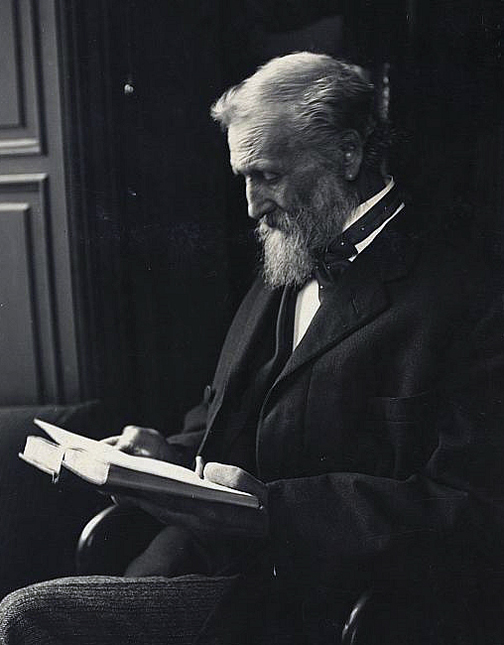John Muir: Cytaty po angielsku
Źródło: 1900s, Our National Parks (1901), chapter 1: The Wild Parks and Forest Reservations of the West <!-- Terry Gifford, EWDB, pages 465-466 -->
Kontekst: Wander here a whole summer, if you can. Thousands of God's wild blessings will search you and soak you as if you were a sponge, and the big days will go by uncounted. If you are business-tangled, and so burdened by duty that only weeks can be got out of the heavy-laden year … give a month at least to this precious reserve. The time will not be taken from the sum of your life. Instead of shortening, it will indefinitely lengthen it and make you truly immortal. Nevermore will time seem short or long, and cares will never again fall heavily on you, but gently and kindly as gifts from heaven.
" A Rival of the Yosemite: The Cañon of the South Fork of King's River, California http://books.google.com/books?id=fWoiAQAAIAAJ&pg=PA77" The Century Magazine, volume XLIII, number 1 (November 1891) pages 77-97 (at page 86)
1890s
letter to Mrs. Ezra S. Carr (1866); published as "The Calypso Borealis, Botanical Enthusiasm" in Boston Recorder, 21 December 1866; republished in Bonnie Johanna Gisel, Kindred & Related Spirits: The Letters of John Muir and Jeanne C. Carr (2001), page 41
Muir's first published writing, concerning the orchid Calypso http://plants.usda.gov/java/profile?symbol=CABU.
1860s
statement by Muir as remembered by Samuel Hall Young in Alaska Days with John Muir (1915), chapter 7
1910s
pages 271-284 (at pages 282-283)
1890s, The National Parks and Forest Reservations, 1895
Travels in Alaska http://www.sierraclub.org/john_muir_exhibit/writings/travels_in_alaska/ (1915), chapter 9: The Discovery of Glacier Bay
1910s
Źródło: 1900s, Our National Parks (1901), chapter 10: The American Forests
"Mount Shasta" in Picturesque California (1888-1890) page 165; reprinted in Steep Trails (1918), chapter 5
1880s
Źródło: 1900s, Our National Parks (1901), chapter 1: The Wild Parks and Forest Reservations of the West
August or September 1875, page 222
John of the Mountains, 1938
letter to Henry Senger http://digitalcollections.pacific.edu/cdm/ref/collection/muirletters/id/14187/show/14186 (22 May 1892)
1890s
"From Fort Independence to Yosemite", San Francisco Daily Evening Bulletin (part 6 of the 11 part series "Summering in the Sierra") dated September 1875, published 15 September 1875; reprinted in John Muir: Summering in the Sierra, edited by Robert Engberg (University of Wisconsin Press, 1984) page 113
1870s
attributed to a Muir "manuscript" in Linnie Marsh Wolfe, Son of the Wilderness: The Life of John Muir (1945), page 124
Similar to statements from My First Summer in the Sierra http://www.sierraclub.org/john_muir_exhibit/writings/my_first_summer_in_the_sierra/, see quotes from 30 August and 2 September above.
1870s
Travels in Alaska http://www.sierraclub.org/john_muir_exhibit/writings/travels_in_alaska/ (1915), chapter 2: Alexander Archipelago and the Home I Found in Alaska
1910s
Źródło: 1900s, Our National Parks (1901), chapter 1: The Wild Parks and Forest Reservations of the West
Źródło: 1890s, The Mountains of California (1894), chapter 8: The Forests <!-- Terry Gifford, EWDB, page 360 -->
letter to Mrs. Ezra S. Carr (December 1872); published as " A Geologist's Winter Walk http://books.google.com/books?id=OAEbAAAAYAAJ&pg=PA355", Overland Monthly, volume 10, number 4 (April 1873) pages 355-358 (at page 358); modified slightly and reprinted in Steep Trails (1918), chapter 2
1870s
"Mount Shasta" in Picturesque California (1888-1890) page 148; reprinted in Steep Trails (1918), chapter 3
1880s
“I am hopelessly and forever a mountaineer.”
letter to Mrs. Ezra S. Carr, from Yosemite Valley (7 October 1874); published in William Federic Badè, The Life and Letters of John Muir http://www.sierraclub.org/john_muir_exhibit/life/life_and_letters/default.aspx (1924), chapter 11: On Widening Currents
1870s
letter to Mrs. Ezra S. Carr, from Yosemite Valley (September 1874); published in William Federic Badè, The Life and Letters of John Muir http://www.sierraclub.org/john_muir_exhibit/life/life_and_letters/default.aspx (1924), chapter 11: On Widening Currents <!-- Terry Gifford, LLO, page 203 -->
(Presumably paraphrasing from the poem Woodnotes by Ralph Waldo Emerson: "Come learn with me the fatal song / Which knits the world in music strong / … / and the ripples in rhymes the oar forsake / The wood is wiser far than thou".)
(Turlock: Town where Muir changed from railroad to foot travel in this particular journey from Oakland, California, to Yosemite Valley.)
1870s
letter to J.B. McChesney http://digitalcollections.pacific.edu/cdm/compoundobject/collection/muirletters/id/12909/rec/84 (19 September 1871)
1870s
"The Summer Flood of Tourists", San Francisco Daily Evening Bulletin (part 1 of the 11 part series "Summering in the Sierra") dated 14 June 1875, published 22 June 1875; reprinted in John Muir: Summering in the Sierra, edited by Robert Engberg (University of Wisconsin Press, 1984) page 71
Advice for visitors to Yosemite given by John Muir at age 37 years. Compare advice given by the 74-year-old Muir below.
1870s
Źródło: 1890s, The Mountains of California (1894), chapter 15: In the Sierra Foot-Hills
journal entry, Island Park, Idaho (26 August 1913) — the last field entry http://digitalcollections.pacific.edu/cdm/ref/collection/muirjournals/id/3843/show/3839 in Muir's last field journal
1910s
“Men use care in purchasing a horse, and are neglectful in choosing friends.”
Attributed to John Mair, not John Muir, in Toasts and Tributes, edited by Arthur Gray (Rohde and Haskins, New York, 1904) page 154.
Misattributed
“Who publishes the sheet-music of the winds, or the written music of water written in river-lines?”
August 1875, page 220
John of the Mountains, 1938
" The Treasures of the Yosemite http://books.google.com/books?id=ZzWgAAAAMAAJ&pg=PA483", The Century Magazine, volume XL, number 4 (August 1890) pages 483-500 (at page 483)
1890s
letter to Mrs. Ezra S. Carr (December 1872); published as " A Geologist's Winter Walk http://books.google.com/books?id=OAEbAAAAYAAJ&pg=PA355", Overland Monthly, volume 10, number 4 (April 1873) pages 355-358 (at page 355); modified slightly and reprinted in Steep Trails (1918), chapter 2
1870s
The Story of My Boyhood and Youth http://www.sierraclub.org/john_muir_exhibit/writings/the_story_of_my_boyhood_and_youth/ (1913), chapter 5: Young Hunters
1910s
